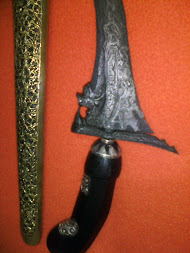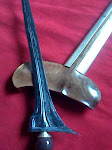Kawali (Badik) is the nation's weapons of driving traditional Buginese. Bugis people themselves call it by various names, such as tappi (which sliped), gajang (booster), and most called kawali. Like Kawali Raja (Bone) and Kawali Rankong (Luwu). There was also named gecong.
Made from coconut leaves (Nypa fruticans). With the master-maker of the
famous dagger ancient magic, the coconut leaves is being massaged
meanwhile the reading of praying (zikir) persistently accompany the rite
until the coconut leaves becomes hard as an iron. The form is thin
& fragrant. This is a rare type of Badik, now no longer makers able
to make that kind of badik. Badik usually only owned by the kings and
his dynasty.
Bone Kawali consists of iron (blades) that flat, rather broad and pointed tip. While kawali Luwu consists of flat iron and straight. Kawali has parts: pangulu (ulu), iron (blades) and wanoa (sarong). In South Sulawesi community knew two types of badik: Badik Saroso and Badik Pateha. Badik Saroso made with ingredients pamor, given the carved wood and silver-plated glove, while pateha badik made with simple shapes, sometimes not with pamor and sheath made of leather or plain wood.
Badik completely made from meteorites stone. Badik makers do not form a master's of pamor, an aura of pamor will appear after forging. pamor is what should be a magical effect on badik. Good Badik is Badik that has an intimate relationship with the owner, such as a strong life connection. Therefore, badik is never bought and sold, only inherited. Because that would be a disaster for those who have no inwardly connection. Kawali making process take place in an atmosphere of ritual. Kawali made without the ritual ceremony, kawali pamor was the same as usual knife. The making of usual kawali will generally completed within seven days.
However, because it will make only done on Fridays, then one kawali with the pamor that is expected to be completed within seven Fridays means it takes 49 days. During the making of kawali, the master maker will constantly read the praying (zikir). Without zikir, usually the pamor that comes from badik made to bring the bad issue so that their owners actually stabbed, or businesses fail, or always sickly.
There are several types badik based on the usefulness of magical effects, such as the Toasi Type of badik that serves to deny the suffering for the owner. Sambang Type can deny the dangers of wild animals. In addition, there are also badik that serves as a sacred trust, like badik Saroso, which has historical value. There are also some who believe that badik useful as a talisman of good and bad influence. To test kawali character, is by holding the edges with your fingertips. When cold, it badik for peace and prosperity. However, if the heat, much less pain in the fingertips, so that's a killer type badik.
Badik usually held with both hands in a horizontal position. Left hand holding a knife sheath and hand upstream badik firmly, ready to draw. How to attract & hold badik like this show that people who hold to understand the philosophy of badik used. For the Bugis, badik pulled from the holster only need to be in a force majeur, circumstances that are considered outside badik holder’s power, or if your opponent is no longer provided an opportunity to make peace. Once badik pull out from its sheathed, its prohibited to put it back to it’s sheath before returning to bleed.
Any Bugis who has puberty must have / keep this sharp objects. In its development kawali more as a symbol of dignity enforcement, affirming courage and responsibility in defending the honor. Among the nobility, kawali also serves as a symbol of power. In general, badik used to defend himself in building self-esteem a person or family. This is based on Siri culture 'with the meanings to defend the dignity of the family. Siri concept 'is already integrated in behavioral, social and cultural system and way of thinking of Bugis, Mandar
Bone Kawali consists of iron (blades) that flat, rather broad and pointed tip. While kawali Luwu consists of flat iron and straight. Kawali has parts: pangulu (ulu), iron (blades) and wanoa (sarong). In South Sulawesi community knew two types of badik: Badik Saroso and Badik Pateha. Badik Saroso made with ingredients pamor, given the carved wood and silver-plated glove, while pateha badik made with simple shapes, sometimes not with pamor and sheath made of leather or plain wood.
Badik completely made from meteorites stone. Badik makers do not form a master's of pamor, an aura of pamor will appear after forging. pamor is what should be a magical effect on badik. Good Badik is Badik that has an intimate relationship with the owner, such as a strong life connection. Therefore, badik is never bought and sold, only inherited. Because that would be a disaster for those who have no inwardly connection. Kawali making process take place in an atmosphere of ritual. Kawali made without the ritual ceremony, kawali pamor was the same as usual knife. The making of usual kawali will generally completed within seven days.
However, because it will make only done on Fridays, then one kawali with the pamor that is expected to be completed within seven Fridays means it takes 49 days. During the making of kawali, the master maker will constantly read the praying (zikir). Without zikir, usually the pamor that comes from badik made to bring the bad issue so that their owners actually stabbed, or businesses fail, or always sickly.
There are several types badik based on the usefulness of magical effects, such as the Toasi Type of badik that serves to deny the suffering for the owner. Sambang Type can deny the dangers of wild animals. In addition, there are also badik that serves as a sacred trust, like badik Saroso, which has historical value. There are also some who believe that badik useful as a talisman of good and bad influence. To test kawali character, is by holding the edges with your fingertips. When cold, it badik for peace and prosperity. However, if the heat, much less pain in the fingertips, so that's a killer type badik.
Badik usually held with both hands in a horizontal position. Left hand holding a knife sheath and hand upstream badik firmly, ready to draw. How to attract & hold badik like this show that people who hold to understand the philosophy of badik used. For the Bugis, badik pulled from the holster only need to be in a force majeur, circumstances that are considered outside badik holder’s power, or if your opponent is no longer provided an opportunity to make peace. Once badik pull out from its sheathed, its prohibited to put it back to it’s sheath before returning to bleed.
Any Bugis who has puberty must have / keep this sharp objects. In its development kawali more as a symbol of dignity enforcement, affirming courage and responsibility in defending the honor. Among the nobility, kawali also serves as a symbol of power. In general, badik used to defend himself in building self-esteem a person or family. This is based on Siri culture 'with the meanings to defend the dignity of the family. Siri concept 'is already integrated in behavioral, social and cultural system and way of thinking of Bugis, Mandar
and Makassar in South
Sulawesi.
Source; http://cerebrobox.blogspot.com














